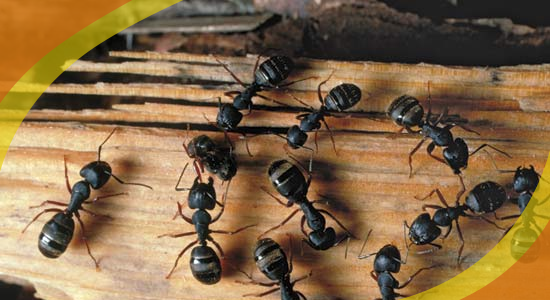
Under the guise of being just a regular ant, the Carpenter ant will stealthily invade your home without you being any the wiser. These wood munching machines are slightly larger in their appearance, and are a high priority for pest control in Canada, as they can cause some serious structural damage to property. Carpenter ant infestations usually occur during the later months of spring and the beginning of fall, as these ants seek out a warm and humid home during the cold winter months. If action is not taken swiftly, these little builders will have no problem expanding and extending their colony and its reach.
How to Spot Carpenter Ants
Carpenter ants are slightly larger than their regular ant counterparts. They vary in colors between brown, black and red, grey, or even a dull yellow in colour. They are usually between ¼ and ½ inch in length. The reproductive swarmer caste are the most recognizable boasting two set of wings: front and hind wings. The worker carpenter ants are equipped with 2 massive mandibles for easy identification.
Their Living Quarters
Carpenter ants create their home from old and rotting wood, trees stumps, roots, fallen branches, and other forms of decaying wooden matter. By hollowing out the inside of the dead wood, these ants are able to create tunnels and tunneling systems throughout the wood. This, in turn, compromises the structural integrity of the structure as a whole, dead stump or home support pillar, it makes no difference to them.
What Do Carpenter Ants Eat?
It is a common misconception that carpenter ants are wood eaters, similar to the termite. This, however, is not the case. Carpenter ants do not eat the food that they make their home in, rather, it is gnashed into a fine sawdust-like state so that it can be more easily moved. Meat, insects, sugars, grains, honey, and pretty much anything else it can find a carpenter ant will eat. They are particularly attracted to the honeydew that is released by insects such as aphids.
Why They Enter Your Home
As they prefer to make their home from softer types of woods, carpenter ants can expand their colonies reach rather easily and rapidly. Rotting or damage wood is an absolute treat for these ants as this wood is much easier to chew and build with. Old or rotting wood around the house is, therefore, the ideal habitat for these ants, enjoying the additional condensation allowed by the rotting wood. Poor air circulation, condensation, as well as access to the soil, are all preferred conditions for carpenter ants to make their homes around.
Truly Nolen Has Your Solution
Truly Nolen has a tried and tested reputation throughout the industry, and have the track record to prove their many successes. Their expert advice and professional service will ensure that all your carpenter ant removal and prevention needs are met and exceeded, with friendly and attentive service to boot. Pest control in Canada has never been in better, more reliable, or effective professional hands.